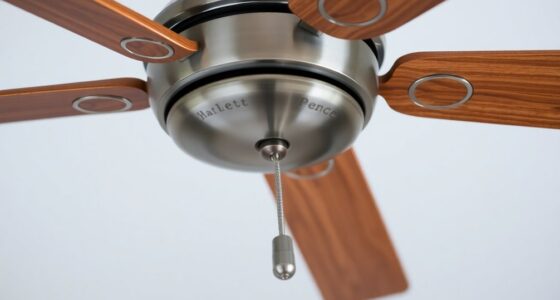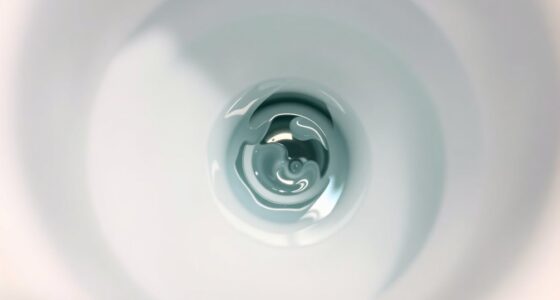Robotic pool cleaners offer precise navigation, thorough cleaning, and low energy use, but they come with a higher upfront cost. Suction cleaners are more affordable, easy to operate, and rely on your pool’s pump, though they may miss spots and increase energy bills. Your choice depends on your budget, pool shape, and how much time you want to save. Want to understand which option fits your needs best? Keep exploring for more insights.
Key Takeaways
- Robotic cleaners offer precise navigation, thorough coverage, and customizable programs, while suction cleaners rely on pool pump water flow and random movement.
- Robotic cleaners are energy-efficient with lower operating costs, whereas suction cleaners depend on pool pumps, increasing energy consumption.
- Robotic cleaners require higher upfront investment but provide automated, low-maintenance operation, unlike suction cleaners needing regular filter and hose maintenance.
- Suction cleaners are generally more affordable initially but may miss hard-to-reach areas and cause additional energy costs.
- Robotic cleaners improve water quality and safety with advanced sensors, while suction cleaners primarily focus on debris removal with less coverage accuracy.
How Robotic Pool Cleaners Operate

Robotic pool cleaners operate independently by maneuvering your pool using built-in sensors and navigation systems. This advanced technology allows them to efficiently cover the entire pool surface, ensuring thorough cleaning. Because they navigate precisely, robotic cleaners promote pool safety by preventing debris buildup that could cause slipping or damage. Their energy efficiency is also notable—since they target specific areas and operate only when needed, they consume less power compared to traditional cleaners. You’ll appreciate how they optimize cleaning without wasting electricity or water. Additionally, their customizable cleaning programs enable users to tailor the cleaning process to their specific pool needs, enhancing overall efficiency. Moreover, their advanced navigation technology ensures comprehensive coverage and minimizes missed spots. Plus, because of their autonomous operation, you don’t have to supervise their work constantly. This combination of smart navigation, energy-saving features, and attention to pool safety makes robotic pool cleaners a convenient choice for maintaining a clean, safe, and efficient pool environment. Their efficient operation also reduces the need for frequent manual intervention, saving time and effort. Furthermore, their ability to adapt to different pool shapes and sizes highlights their versatility in various pool environments. The inclusion of smart sensors further improves their precision and effectiveness during cleaning sessions.
How Suction Pool Cleaners Function

Suction pool cleaners use powerful motors to generate strong suction, pulling debris from the pool floor and walls. They rely on a filtration system to trap dirt and prevent clogs, ensuring efficient cleaning. As they move across the pool surface, their navigation mechanisms help them cover the area systematically. Additionally, some models incorporate filtration technologies such as HEPA or activated carbon filters to enhance debris removal and improve water quality. Many designs also feature unique and wicked planters to optimize cleaning paths and efficiency. To maintain optimal performance, regular filter maintenance is essential to prevent reduced suction power and prolong the lifespan of the cleaner. Regularly inspecting and replacing filters can also prevent potential skin irritation, especially for sensitive skin types. Furthermore, staying informed about automated systems can help in maintaining the cleaner’s effectiveness and integrating it with other pool management tools.
Suction Power Mechanics
Suction pool cleaners operate by creating a powerful vacuum that lifts debris from the pool surface and floor. This vacuum is generated by a pump that pulls water and debris into the cleaner’s hose and filter bag. The suction power depends on the pump’s strength, impacting energy efficiency and cleaning effectiveness. You’ll want a model with consistent suction to handle both large and fine debris efficiently. Regular maintenance, such as cleaning filters and checking hoses, guarantees maximum suction and prolongs your cleaner’s lifespan. Proper seal integrity is essential to maintain consistent suction levels and prevent leaks, which can diminish cleaning performance. Additionally, ensuring proper installation helps optimize the cleaner’s function and reduces potential issues. Properly maintained hoses and seals contribute significantly to overall suction performance and longevity. To maximize efficiency, choosing a system with adequate pump power ensures the debris is effectively picked up without excessive energy consumption. Moreover, selecting models with energy-efficient motors can help reduce operational costs while maintaining cleaning performance.
Filtration Process Overview
The effectiveness of a suction pool cleaner depends heavily on its filtration system, which traps debris as water flows through it. A high filtering efficiency ensures that dirt, leaves, and small particles are captured, keeping your pool cleaner for longer. Typically, these cleaners use a fine mesh or cartridge filter that collects debris before the water is returned to the pool. Maintenance requirements are straightforward but essential; you’ll need to regularly clean or replace the filter to prevent clogs and maintain ideal flow. Neglecting this can reduce filtering efficiency and strain the cleaner’s motor. Properly maintaining the filter system ensures your suction cleaner performs at its best, providing consistent cleaning and extending its lifespan. Additionally, filter maintenance plays a critical role in preventing bacteria buildup and maintaining water quality.
Understanding how suction pool cleaners move and navigate is key to appreciating their cleaning efficiency. They rely on water flow, created by the pump, to propel and steer themselves around your pool. Usually, they follow a random pattern, bumping into walls and obstacles, ensuring broad coverage. This method saves energy but might miss spots, affecting swimming pool safety if not monitored. Their movement depends on the pump’s power, influencing energy consumption. To help you compare, here’s a quick overview:
| Feature | Details |
|---|---|
| Movement Pattern | Random, bump-and-turn |
| Navigation System | Water flow-driven, no sensors |
| Impact on Energy Use | Moderate, varies with pump settings |
Additionally, some models incorporate automatic shutoff features to prevent overworking the pump and conserve energy. Proper maintenance of the pool filtration system can further enhance the efficiency of suction pool cleaners. Regularly cleaning and inspecting the filter components ensures optimal water flow and movement accuracy. Maintaining proper water chemistry can also help prevent blockages and improve overall cleaning performance.
Advantages of Robotic Pool Cleaners
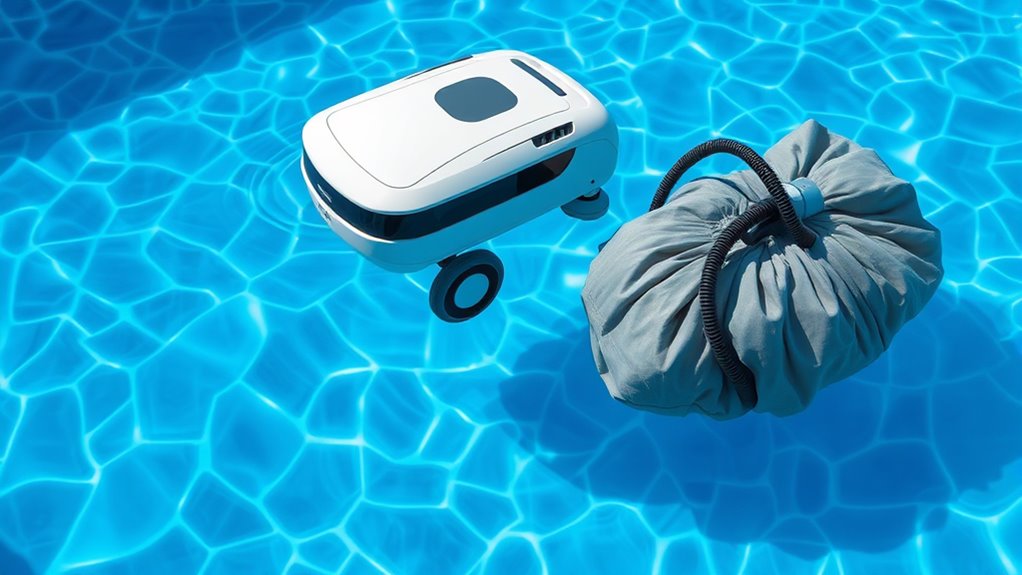
Robotic pool cleaners offer automated cleaning that saves you time and effort. With advanced navigation systems, they cover the entire pool efficiently without missing spots. Plus, their smart features reduce the need for manual labor, making pool maintenance easier for you. Additionally, some models include smart features like sensors, which help optimize cleaning performance and adapt to different pool conditions. For example, understanding Glycolic Acid Benefits for Skin can be complex, much like understanding the full capabilities of advanced pool cleaning technology.
Automated Cleaning Efficiency
Because robotic pool cleaners are designed with advanced navigation systems, they can efficiently cover the entire pool surface without missing spots. This means you spend less time supervising and more time enjoying your pool. Their precise cleaning cycles help maintain ideal water quality, reducing the need for frequent manual cleaning. Plus, robotic cleaners typically operate on low energy consumption, making them cost-effective and eco-friendly. Their automated features ensure consistent cleaning, which helps you stick to maintenance schedules easily. You won’t have to worry about missed spots or uneven cleaning, saving you effort and time. Overall, their automated cleaning efficiency keeps your pool sparkling with minimal input, making them a smart choice for hassle-free maintenance.
Advanced Navigation Systems
Thanks to their advanced navigation systems, robotic pool cleaners can precisely scan and map your pool’s layout, ensuring thorough coverage without missing spots. Their sensor accuracy allows them to detect obstacles, walls, and water features, adjusting their path accordingly. This intelligent navigation prevents unnecessary overlaps and saves time. Additionally, these systems optimize cleaning routes, making the process more efficient. You’ll also notice improved battery longevity because the cleaner conserves power by avoiding redundant movements. This means longer cleaning cycles between charges and fewer interruptions. Overall, the advanced navigation systems give robotic pool cleaners a significant edge by providing all-encompassing, efficient cleaning while maximizing their operational lifespan. With these features, you can enjoy a cleaner pool with less hassle and more reliable performance. The importance of accurate sensor detection helps improve overall cleaning efficiency and performance.
Time and Labor Savings
With their automated operation, robotic pool cleaners substantially reduce the time and effort needed to keep your pool clean. They handle the job independently, so you don’t spend hours scrubbing or vacuuming manually. This saves you valuable time and labor, allowing you to enjoy your pool more. While robotic cleaners do consume energy, their energy consumption is generally efficient, especially compared to manual cleaning methods. Maintenance requirements are minimal; most robotic models only need periodic cleaning of filters and brushes. This means fewer chores and less hassle for you. Overall, robotic pool cleaners deliver significant time and labor savings, making pool maintenance easier and more convenient without sacrificing cleanliness or efficiency.
Benefits of Suction Pool Cleaners

Suction pool cleaners offer several advantages that make them a popular choice for maintaining a clean pool. They effectively remove debris and dirt, ensuring your water stays clear and inviting. Plus, they help stabilize your pool’s chemical balance by removing organic matter that can disrupt water chemistry. These cleaners adapt well to different water temperatures, maintaining performance regardless of seasonal changes. They’re also compatible with your existing filtration system, reducing the need for additional equipment. Here’s a quick comparison:
| Feature | Benefit |
|---|---|
| Pool chemical control | Keeps water chemistry balanced by removing debris |
| Water temperature | Performs consistently across seasons |
This reliability saves you time and effort, keeping your pool pristine year-round.
Potential Drawbacks of Each Type
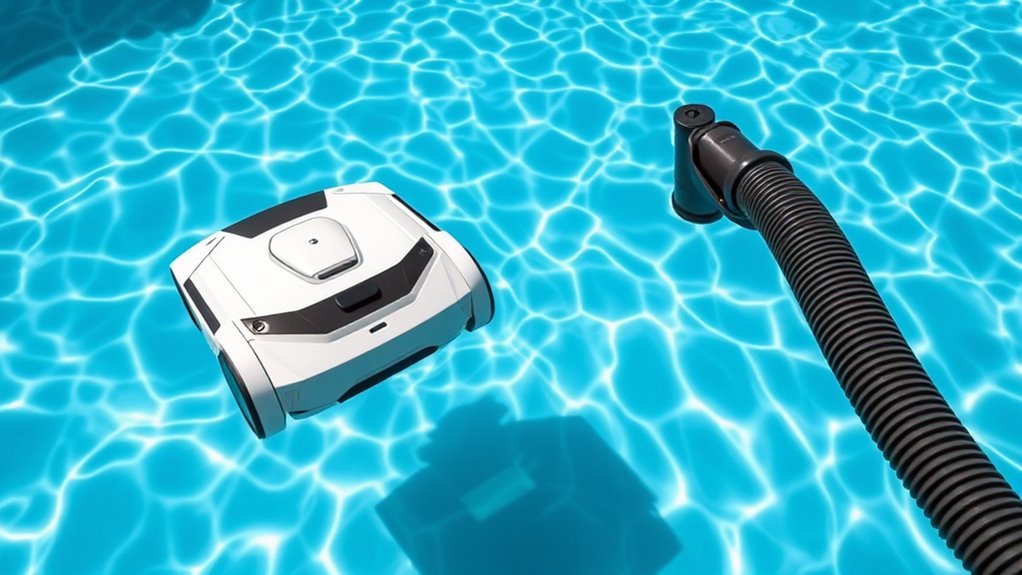
While suction pool cleaners are effective at maintaining water clarity, they do come with some limitations. First, the maintenance costs can add up, as parts like hoses and filters need regular replacement or cleaning. Second, they tend to be noisier, which might disturb your relaxation or outdoor activities. Third, their cleaning efficiency can be limited to certain pool areas, leaving corners or steps untouched. You might find yourself spending extra time manually cleaning these spots. Additionally, their reliance on pool pumps can strain your system, increasing energy bills. The noise levels can be particularly bothersome during use, and ongoing maintenance costs can make them less economical over time. Being aware of these drawbacks helps you make an informed decision suited to your needs.
Factors to Consider When Choosing a Pool Cleaner
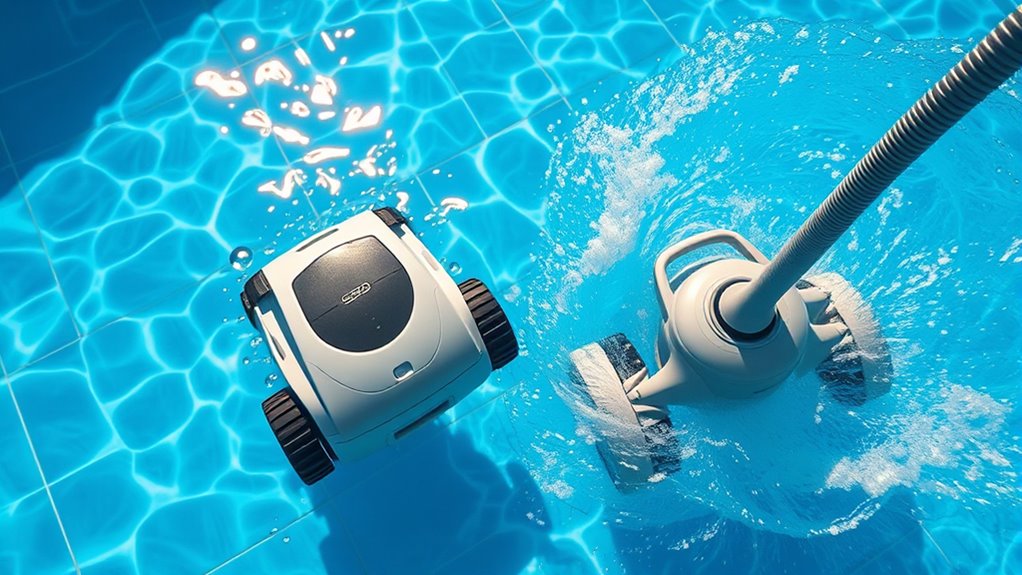
Choosing the right pool cleaner depends on several important factors. First, consider your pool size; larger pools may require more powerful or extensive cleaning options, like robotic cleaners with better coverage. Smaller pools might do well with basic suction models. Budget considerations are also vital—robotic cleaners tend to be more expensive upfront but can save time and effort long-term. Think about your maintenance preferences: if you want a set-it-and-forget-it solution, a robotic cleaner might be ideal. However, if you’re on a tight budget, a suction cleaner could be sufficient. Also, evaluate your pool’s shape and debris level, as these influence the cleaner type that will work best. Balancing these factors helps you choose a cleaner that fits your needs and budget effectively.
Frequently Asked Questions
How Long Do Robotic and Suction Pool Cleaners Typically Last?
You might wonder how long your pool cleaner lasts. Robotic cleaners usually have a battery life of 1 to 3 years, depending on usage and maintenance, while suction models often last 5 to 8 years with minimal repair costs. Regularly cleaning filters and checking for wear can extend their lifespan. Keep in mind, robotic cleaners may need more repairs due to battery and motor issues over time.
Are Robotic Pool Cleaners Suitable for All Pool Sizes and Shapes?
Imagine fitting a puzzle piece into any shape—that’s how robotic pool cleaners adapt to different pool sizes and shapes. They’re usually suitable for most pools, whether round, rectangular, or irregular. However, larger pools might require longer cleaning times, and some complex shapes could challenge smaller models. So, you can generally rely on them, but check the specs to verify your pool size and shape fit their capabilities.
What Maintenance Is Required for Each Type of Pool Cleaner?
You need to regularly maintain both types of pool cleaners to keep them working efficiently. For robotic cleaners, check and replace filters as needed and occasionally lubricate the motor to prevent wear. Suction cleaners also require filter replacement to avoid clogs and ensure proper suction. Both should be inspected for debris buildup and cleaned regularly, which helps extend their lifespan and keeps your pool sparkling.
Can Robotic and Suction Cleaners Handle Debris of All Sizes?
You wonder if robotic and suction cleaners can handle debris of all sizes. Robotic cleaners often excel with debris filtration, capturing fine particles and some larger debris thanks to advanced filters. Suction cleaners rely on strong suction power, but their motor durability may limit handling bigger debris or frequent large debris. Both types are effective for regular maintenance, but robotic models generally offer better debris filtration for a wider range of debris sizes.
Are There Safety Concerns Associated With Using Either Type of Cleaner?
When using pool cleaners, safety is key. You should always prioritize pool chemical safety and electrical safety to prevent accidents. Both robotic and suction cleaners are generally safe if used correctly, but always follow manufacturer instructions. Keep electrical cords away from water, and regularly check for damage. Never operate cleaners if there’s a risk of electrical faults, and ensure your pool chemicals are stored and handled properly to avoid hazards.
Conclusion
Choosing between robotic and suction pool cleaners is like picking the right tool for a job—you’ll want one that fits your needs. Robotic cleaners are like diligent robots, tackling dirt with precision, while suction cleaners work like steady workers, keeping your pool tidy. Consider your pool size, budget, and maintenance preferences. Ultimately, selecting the right cleaner is about finding the perfect partner to keep your pool sparkling—so you can enjoy those clear waters without the hassle.




